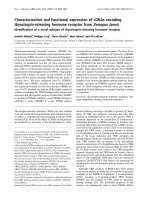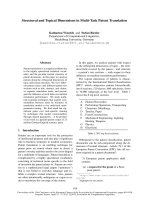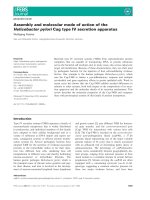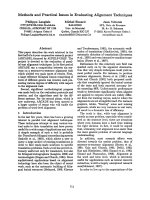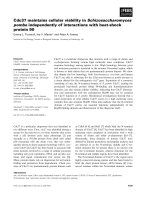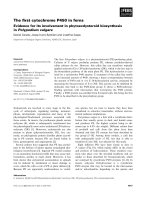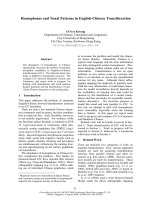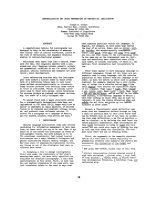Báo cáo khoa học: Neuroglobin and cytoglobin expression in mice Evidence for a correlation with reactive oxygen species scavenging doc
Bạn đang xem bản rút gọn của tài liệu. Xem và tải ngay bản đầy đủ của tài liệu tại đây (289.18 KB, 6 trang )
Neuroglobin and cytoglobin expression in mice
Evidence for a correlation with reactive oxygen species scavenging
Elke Fordel, Liesbet Thijs, Luc Moens and Sylvia Dewilde
Department of Biomedical Sciences, University of Antwerp, Belgium
Both hypoxia (lack of O
2
relative to metabolic needs)
and reoxygenation (reintroduction of O
2
to hypoxic
tissue) are important in human pathophysiology.
Prominent examples of tissue hypoxia that predispose
to injury during reoxygenation include myocardial isc-
hemia, stroke and transplantation of organs. Under-
standing the role of reactive oxygen species (ROS) in
reoxygenation injury has the potential to lead to ther-
apies that could improve public health [1]. Although
ROS at physiologic concentrations may be required
for normal cell function, excessive production of ROS
is detrimental to cells, because ROS cause oxidative
damage to lipids, proteins, and DNA. All cells possess
a complex antioxidant system to detoxify ROS. Under
normal conditions, antioxidant enzymes act in concert
to remove various ROS produced by free radical reac-
tions (Cu ⁄ Zn-superoxide dismutase and Mn-superoxide
dismutase, catalase, and glutathione peroxidase) [1].
Neuroglobin (Ngb) and cytoglobin (Cygb) are two
new members of the globin family. Ngb is mainly
expressed in the cytoplasm of neuronal (brain and
retina) and some endocrine tissues, whereas Cygb is
detected in the nucleus and in the cytoplasm of many
types of tissue [2,3]. In response to hypoxia, Ngb is up-
regulated in vitro [4,5], and protects neurons against
hypoxic damage. However, there are contradictory
data as to whether Ngb is upregulated under hypoxic
conditions in brain [4,6,7]. Several factors, namely spe-
cies, brain region, severity and duration of hypoxia,
and the pattern of hypoxic exposures, could have
accounted for such disparate findings [8]. Cygb is up-
regulated in vitro [4] and in vivo under hypoxia [4,9].
Disparities between Ngb and Cygb responses to hyp-
oxia suggest that these two globins may play different
roles. Recently, a possible role in ROS detoxification
was suggested for Ngb and Cygb in brain and retina.
Keywords
cytoglobin; eyes; hypoxia; neuroglobin;
reactive oxygen species
Correspondence
S. Dewilde, Department of Biomedical
Sciences, University of Antwerp,
Universiteitsplein 1, B-2610 Antwerp,
Belgium
Fax: +32 3 8202248
Tel: +32 3 8202392
E-mail:
(Received 29 September 2006, revised 7
December 2006, accepted 4 January 2007)
doi:10.1111/j.1742-4658.2007.05679.x
Although essentially unknown, several functions are hypothesized for neu-
roglobin and cytoglobin, two new members of the globin family. In this
article, we try to shed more light on their possible roles in hypoxia and
detoxification of reactive oxygen species in vivo. The relative transcriptional
changes of neuroglobin and cytoglobin in a situation of chronic hypoxia in
mice were examined using real-time quantitative PCR. The kinetics of the
hypoxic expression of neuroglobin (brain, eyes) and cytoglobin (brain, eyes,
liver, heart, skeletal muscle) is organ-specific. Moreover, reactive oxygen
species production is higher in liver than in the other tissues. In eyes,
the negative correlation, after reoxygenation, between neuroglobin protein
level and H
2
O
2
concentration is a first proof of a reactive oxygen species-
scavenging function for neuroglobin. In addition, apoptotic cell death after
hypoxia is for the first time demonstrated in heart and liver.
Abbreviations
Cygb, cytoglobin; HIF, hypoxia-inducible factor; Ngb, neuroglobin; ROS, reactive oxygen species; VEGF, vascular endothelial growth factor.
1312 FEBS Journal 274 (2007) 1312–1317 ª 2007 The Authors Journal compilation ª 2007 FEBS
Fago et al. [10] described a mathematical model of ret-
inal O
2
supply that argues that Ngb plays a role in
scavenging ROS and reactive nitrogen species that are
generated following hypoxia. Ostojic et al. [11] tried to
find an explanation for why the retina is capable of
tolerating an almost 10 times longer period of ischemia
than brain. They described how the presence of hypo-
xia in the retina is consistent with the finding of
increased hypoxia-inducible factor (HIF)-1a and up-
regulation of Cygb mRNA, and hypothesized that
Cygb (and Ngb) may have a vital role in retinal oxy-
gen homeostasis, enabling the retina to sustain longer
periods of ischemia.
Our previous study [4] showed that Cygb is signifi-
cantly upregulated upon 48 h of hypoxia, and that this
increase is dependent on the tissue and the severity of
hypoxia. The mechanism of induction of Cygb is regu-
lated by HIF-1. The aim of this study was to illustrate
the time dependency and the tissue specificity of Cygb
and Ngb mRNA upregulation upon hypoxia and after
reoxygenation. In addition, we tried to shed light on
the ROS-scavenging function of Ngb and on the mech-
anism of cell death after hypoxic exposure.
Results and Discussion
As can be seen in Fig. 1, the mRNA upregulation is
dependent on the hypoxia exposure time and is tissue-
specific. Vascular endothelial growth factor (VEGF)
[12] and Mb [13] were used as positive controls, as
they are both known to be regulated by hypoxia. As
expected, the HIF-1a upregulation was negligible in all
tissues, which confirms that HIF-1a is not transcrip-
tionally regulated, but is rather regulated at the post-
mRNA level [14]. However, in liver, statistically signifi-
cant upregulation after 48 h of hypoxia ± 8 h of
reoxygenation can be seen. The liver is unique because
of its physiologic O
2
gradient [15]. Under normal con-
ditions, periportal (pO
2
high) and perivenous (pO
2
low) cells need the same levels of HIF proteins, but
under abnormal conditions leading to hypoxia the
perivenous cells need more HIF proteins within short
periods of time. Therefore, they contain higher levels
of HIF-a mRNA, so the HIF-a proteins can be eleva-
ted rapidly by de novo protein synthesis using pre-exist-
ing mRNA [15]. This could possibly explain the higher
level of HIF-1a mRNA after long-term hypoxia and
short-term reoxygenation, in comparison with the
other tissues (Fig. 1).
Cygb upregulation gradually increases as a function
of time, and reaches maximal levels after 48 h of hyp-
oxia in brain, heart, and liver. For muscle, the highest
upregulation is also obtained after 48 h, but a drop
can be seen around 12 h, although it is not statistically
significant. For eyes, however, Cygb is maximally
expressed around 24 h. After reoxygenation, the
upregulation gradually decreases for all tissues; the
slowest decreases are in liver and heart. Ngb expres-
sion follows the same trends.
In heart, Cygb mRNA upregulation only starts after
48 h of hypoxia. This could be due to the presence of
mechanisms for self-protection under the pernicious
conditions of hypoxia [16]. These mechanisms are
directed towards a restoration of the normal ratio of
energy demand versus energy supply [16].
In eyes, the upregulation of Ngb is higher than that
of VEGF, and starts earlier than in the other tissues.
The retina is extremely prone to oxidative damage,
owing to its relatively high O
2
consumption and its
constant exposure to light. Oxidative stress is thought
to be involved in the pathogenesis of many ocular dis-
eases [17]. Schmidt et al. [18] showed that Ngb is
highly expressed in the murine retina, and that the
intraretinal distribution of Ngb correlates with the
relative oxygen consumption. Although still a matter
of debate, the estimated local concentration of Ngb in
the mouse retina is > 100 lm, and is thus within the
range of Mb in the muscle, indicating the important
role of Ngb in retinal function [18]. However, in con-
trast to Mb, the O
2
affinity of Ngb is markedly sensi-
tive to changes in pH and temperature [10]. Under
physiologic conditions, the O
2
affinity is much lower
(P
50
7.5 versus 1), whereby only a small fraction of
Ngb would be saturated with O
2
under normal condi-
tions. According to a mathematical model, Ngb would
therefore improve O
2
supply only at concentrations
exceeding 300 lm [10]. A more likely role appears to
be cellular detoxification of free radicals and related
oxidizing species.
To unravel the possible ROS-scavenging function of
Ngb and Cygb, ROS levels, expressed as pmol H
2
O
2
(Fig. 2), were followed in first order as a function of
time for the different tissues. The obtained values for
eyes, brain, muscle and heart were all in the same
range (1–11 pmol), whereas the values for liver were
all higher (18–35 pmol). This is to be expected, as the
liver is more tolerant to hypoxia [15] and thus more
tolerant to higher H
2
O
2
levels. For brain and eyes,
there was a gradual increase in the amount of H
2
O
2
after hypoxia and reoxygenation. In heart, muscle and
liver, the H
2
O
2
level dropped after 24 h of reoxygena-
tion. The correlation between ROS detection and pro-
tein level was studied in second order. As can be seen
in Fig. 3, in eyes, during hypoxic incubation, H
2
O
2
production remained at levels comparable with norm-
oxia. This finding was expected, as it is reoxygenation,
E. Fordel et al. Neuroglobin as ROS scavenger?
FEBS Journal 274 (2007) 1312–1317 ª 2007 The Authors Journal compilation ª 2007 FEBS 1313
rather than hypoxia, that induces ROS production
(reperfusion injury). After 48 h of hypoxia, Ngb pro-
tein expression, relative to normoxia, was upregulated
almost two-fold. In comparison to 48 h of hypoxia,
the Ngb protein upregulation decreased after reoxygen-
ation, whereas the H
2
O
2
level increased. This negative
correlation can be interpreted as a scavenger function
for Ngb. For Ngb in brain, this negative correlation
was less clear. This result is in agreement with previous
in vitro experiments in our laboratory [19], which
clearly indicated that Ngb protects human SH-SY5Y
neuroblastoma cells from H
2
O
2
-induced cell death.
Herold et al. [20] also studied the in vitro reaction of
Ngb with H
2
O
2
,NO
Æ
and peroxynitrite, and showed
that Ngb is an efficient scavenger of ROS. Upon hyp-
oxia ⁄ reperfusion, NO
Æ
production rises dramatically up
to low micromolar levels [21], and the superoxide level
is increased in neurons [22]. Although most NO
Æ
is rap-
idly scavenged by Hb, acute endogenously produced
NO
Æ
can be scavenged by Ngb, depending on the
ligation and oxidation state of the iron center of
the heme. A major fate of the excess NO
Æ
appears to
AB
C
E
D
Fig. 1. Absolute mRNA upregulation in mice under hypoxic conditions and after reoxygenation. Real-time quantitative PCR results of the
absolute mRNA upregulation of VEGF, Mb, HIF-1a, Ngb and Cygb in eyes (A), brain (B), skeletal muscle (C), heart (D), and liver (E). 48R8,
48R24: 48 h of hypoxia, followed by 8 h or 24 h of reoxygenation. Data are expressed as mean ± SEM of two independent experiments,
each with three mice. *Statistically significant difference from the reference normoxic condition (P ¼ 0.05).
Neuroglobin as ROS scavenger? E. Fordel et al.
1314 FEBS Journal 274 (2007) 1312–1317 ª 2007 The Authors Journal compilation ª 2007 FEBS
be the reaction with superoxide to form peroxynitrite.
In the Fe
2+
–NO form, Ngb reacts more rapidly with
ONOO
–
than does Hb. In contrast to Hb and Mb, the
reaction of met(Fe
3+
) Ngb with ONOO
–
or H
2
O
2
does
not appear to generate the cytotoxic ferryl (Fe
4+
) spe-
cies, which results in the formation of secondary pro-
tein radicals. This feature of Ngb may be related to the
hexacoordinated heme [21]. The ROS-scavenging reac-
tion of Ngb may thus contribute to neuronal survival
following hypoxic ⁄ ischemic episodes, provided that the
heme is in the Fe
2+
–NO form. This appears plausible
at least in the retina, where relatively high levels of
Ngb are localized [18]. As well as the heme, other
components may also contribute to ROS scavenging,
such as reactive thiols, which are readily accessible to
oxidizing agents [21]. The exact mechanism by which
Ngb protects against oxidative stress remains to be elu-
cidated.
Investigation of mechanisms of cell death during cell
injury in vivo caused by ischemia and reperfusion is of
clinical importance, but technically difficult. In heart
and liver, apoptotic cell death is demonstrated for the
first time by incubation with the cleaved caspase-3
antibody (Fig. 4). Caspase-3 is one of the key executers
of apoptosis, as it is responsible for the proteolytic
cleavage of many key proteins such as the nuclear
enzyme poly(ADP-ribose) polymerase. The highest sig-
nal is seen after 48 h of hypoxia, and it gradually
declines during reoxygenation. Communal et al. [23]
and Liu et al. [24] described the important role of
apoptosis in heart and liver diseases, respectively. In
skeletal muscle, brain and eyes, apoptotic cell death
could not be demonstrated. Hypoxia ⁄ ischemia may
simultaneously activate multiple mechanisms of cell
death to varying degrees, resulting in a spectrum of
morphologic changes ranging from apoptosis to necro-
sis [25], and may thus not be clearly detectable on
western blot in these organs.
Experimental procedures
Induction of hypoxia
Swiss-CD1 mice were kept in a chamber maintained at 7%
O
2
(premixed gases: 7% O
2
, 93% N
2
; Messer, Machelen,
Belgium). Mice were provided with food and water
ad libitum, and allowed to adjust to the hypoxic environ-
ment by gradually decreasing O
2
from 21% (normoxia) to
7% (hypoxia) over an adaptation time of 1 h. After 2 h,
4 h, 6 h, 12 h, 24 h and 48 h of hypoxic exposure, the ani-
0
10
20
30
40
50
eyes brain
*
*
*
*
muscle heart liver
H
2
O
2
level (pmol)
N
H48
48R8
48R24
Fig. 2. H
2
O
2
level measured in mice under hypoxic conditions and
after reoxygenation. Evolution of ROS detection, expressed as
H
2
O
2
level, in different tissues when mice are exposed to normoxia
(N) or hypoxia (H) for 48 h, and after reoxygenation. 48R8, 48R24:
48 h of hypoxia, followed by 8 h or 24 h of reoxygenation. Data are
expressed as mean ± SEM of three independent experiments.
*Statistically significant difference from the normoxic condition
(P ¼ 0.05).
Fig. 3. Relative Ngb protein expression and H
2
O
2
level in mice
under hypoxic conditions and after reoxygenation. Comparison
between Ngb protein expression (normoxia ¼ 100%, normalization
with b-actin) and H
2
O
2
level to investigate the ROS-scavenging
function of Ngb in eyes. H: hypoxia. 48R8, 48R24: 48 h of hypoxia,
followed by 8 h or 24 h of reoxygenation.
Fig. 4. Western blot detection in mice under hypoxic conditions
and after reoxygenation. Cleaved caspase-3 protein expression in
heart and liver under hypoxic (H) conditions (48 h) and after reoxy-
genation (48R8, 48R24: 48 h of hypoxia, followed by 8 h or 24 h of
reoxygenation). Positive control: U937 monocytes treated with
50 l
M etoposide for 5 h.
E. Fordel et al. Neuroglobin as ROS scavenger?
FEBS Journal 274 (2007) 1312–1317 ª 2007 The Authors Journal compilation ª 2007 FEBS 1315
mals were killed, and the dissected organs (brain, liver,
heart, skeletal muscle, eyes) were frozen in liquid nitrogen
and stored at ) 80 °C until further processing. The influence
of reoxygenation (8 h and 24 h) was tested after 48 h of
hypoxia. All procedures were approved by the local ethics
committee of the University of Antwerp, and conformed to
European Community regulations.
RNA extraction and real-time quantitative PCR
For RNA extraction, the TriZol method (Invitrogen, Carls-
bad, CA, USA) was used, followed by LiCl precipitation
(Ambion, Austin, TX, USA). cDNA was synthesized using
random primers (Promega, Madison, WI, USA) and Super-
script II RT enzyme according to the manufacturer’s
instructions (Invitrogen). Real-time quantitative PCR was
performed using the ABI PRISM 7000 Sequence Detector
(Applied Biosystems, Foster City, CA, USA), with the
qPCR mastermix (Eurogentec, Seraing, Belgium) and Taq-
Man Gene expression assays (Applied Biosystems) for Ngb,
Cygb and HIF-1a. The parameters for PCR amplification
were 50 °C for 2 min, 95 °C for 10 min, and by 40 cycles
of 95 °C for 15 s and 60 °C for 1 min. Each PCR reaction,
including the nontemplate control, was performed in tripli-
cate. VEGF and Mb were used as positive control genes.
Several housekeeping genes were tested to choose the best
internal control for each tissue (hydroxymethylbilane syn-
thase for brain, eyes and skeletal muscle; small-subunit
RNA for liver; and TATA box-binding protein for heart).
The relative expression of mRNA was calculated using the
comparative threshold cycle method.
ROS detection
The Amplex Red Hydrogen peroxide Assay kit (Molecular
Probes, Eugene, OR, USA) was used to detect H
2
O
2
. In the
presence of horseradish peroxidase, the Amplex Red reagent
reacts with H
2
O
2
to produce highly fluorescent resorufin.
Tissues were washed with ice-cold NaCl ⁄ P
i
and homogenized
in extraction buffer. After two centrifugation steps (10 min
1000 g, 10 min 9000 g)at4°C on a Biofuge 13 centrifuge
with 3743 rotor (Heraeus Instruments, Niedersachsen, Ger-
many) 50 lg of total protein was added to a reaction mixture
that contained 50 lm Amplex Red and 1 UÆmL
)1
horserad-
ish peroxidase. The excitation ⁄ emission wavelength filters
were 544 nm ⁄ 590 nm. Each experimental condition was run
in duplicate, and the mean ± SEM was calculated. Fluores-
cence changes from the cells were converted to pmol released
H
2
O
2
using a standard curve (0–200 pmol).
Protein extraction and western blotting
Tissues were crushed in liquid nitrogen and dissolved in lysis
buffer [100 mm NaCl, 1 mm EDTA, 10 mm Tris ⁄ HCl,
pH 7.5 plus protease inhibitor Complete (Roche Diagnos-
tics, Basel, Switzerland)]. Samples were homogenized and
sonicated. Samples (20 lg) were run on a 12.5% polyacryla-
mide gel and electroblotted onto an Immobilon P membrane
(Millipore, Billerica, MA, USA). Membranes were blocked
in Tris-buffered saline containing 0.05% Tween-20 (TBS-T)
and 5% nonfat dry milk for 1 h. After blocking, membranes
were probed overnight at 4 °C with primary antibody
[1 ⁄ 1000, Ngb and Cygb polyclonal antibodies [2]; 1 ⁄ 10 000,
monoclonal anti-b-actin (Sigma-Aldrich, St Louis, MO,
USA); 1 ⁄ 1000, polyclonal cleaved caspase-3 (Cell Signaling,
Danvers, MA, USA)] in antibody dilution buffer (TBS-T
containing 1% nonfat dry milk). Membranes were washed
with antibody dilution buffer and incubated with horserad-
ish peroxidase-labeled secondary antibody (1 ⁄ 2000; Dako,
Copenhagen, Denmark) for 1 h at room temperature. After
washing, antibody detection was accomplished with Super-
signal West Femto maximum sensitivity substrate (Pierce,
Rockford, IL, USA). The cleaved caspase-3 antibody detects
endogenous levels of the large fragment (17 ⁄ 19 kDa) of acti-
vated caspase-3 resulting from cleavage adjacent to Asp175.
The antibody does not recognize full-length caspase-3 or
other cleaved caspases. Signals were detected using a Lumi-
Imager (Roche Diagnostics). image quant (Molecular
Dynamics, Amersham Biosciences, NJ, USA) was used for
quantitation, using b-actin for normalization.
Statistics
Statistical analysis of data utilized anova with least signifi-
cant difference and Bonferroni post hoc tests (P £ 0.05).
Acknowledgements
We thank unknown referees for valuable comments.
We would like to thank K. Brys and Professor Dr J.
Vanfleteren (University of Ghent) for help with the
ROS detection experiments. Professor Dr P. D’Haese
(University of Antwerp) is acknowledged for giving us
the opportunity to work on the ABI Prism 7000
Sequence detector. Dr B. M. y. Keenoy (University of
Antwerp) is acknowledged for giving us the opportunity
to work on the Fluoroskan Ascent Microplate Fluorim-
eter. We wish to thank E. Geuens for helping us with
the antibodies. This study was supported by a grant
from EU (QLG-CT-2002-01548, ‘Neuroglobin and the
survival of the neuron’) to LM. SD is a postdoctoral fel-
low of the Fund of Scientific Research Flanders (FWO).
References
1 Ran Q, Liang H, Gu M, Qi W, Walter CA, Roberts LJ,
Herman B, Richardson A & Van Remmen H (2004)
Neuroglobin as ROS scavenger? E. Fordel et al.
1316 FEBS Journal 274 (2007) 1312–1317 ª 2007 The Authors Journal compilation ª 2007 FEBS
Transgenic mice overexpressing glutathione peroxidase 4
are protected against oxidative stress-induced apoptosis.
J Biol Chem 279, 55137–55146.
2 Geuens E, Brouns I, Flamez D, Dewilde S, Timmer-
mans JP & Moens L (2003) A globin in the nucleus!
J Biol Chem 278, 30417–30420.
3 Burmester T, Ebner B, Weich B & Hankeln T (2002)
Cytoglobin: a novel globin type ubiquitously expressed
in vertebrate tissues. Mol Biol Evol 19, 416–421.
4 Fordel E, Geuens E, Dewilde S, Rottiers P, Carmeliet
P, Grooten J & Moens L (2004) Cytoglobin expression
is upregulated in all tissues upon hypoxia: an in vitro
and in vivo study by quantitative real-time PCR.
Biochem Biophys Res Commun 319, 342–348.
5 Sun Y, Jin K, Mao XO, Zhu Y & Greenberg DA
(2001) Neuroglobin is up-regulated by and protects neu-
rons from hypoxic–ischemic injury. Proc Natl Acad Sci
USA 98, 15306–15311.
6 Mammen PP, Shelton JM, Goetsch SC, Williams SC,
Richardson JA, Garry MG & Garry DJ (2002) Neuro-
globin, a novel member of the globin family, is
expressed in focal regions of the brain. J Histochem
Cytochem 50, 1591–1598.
7 Sun Y, Jin K, Peel A, Mao XO, Xie L & Greenberg
DA (2003) Neuroglobin protects the brain from experi-
mental stroke in vivo. Proc Natl Acad Sci USA 100,
3497–3500.
8 Li RC, Lee SK, Pouranfar F, Brittian KR, Clair HB,
Row BW, Wang Y & Gozal D (2006) Hypoxia differen-
tially regulates the expression of neuroglobin and cyto-
globin in rat brain. Brain Res 1096(1), 173–179.
9 Schmidt M, Gerlach F, Avivi A, Laufs T, Wystub S,
Simpson JC, Nevo E, Saaler-Reinhardt S, Reuss S,
Hankeln T et al. (2004) Cytoglobin is a respiratory
protein in connective tissue and neurons, which is
up-regulated by hypoxia. J Biol Chem 279, 8063–8069.
10 Fago A, Hundahl C, Malte H & Weber RE (2004)
Functional properties of neuroglobin and cytoglobin.
Insights into the ancestral physiological roles of globins.
IUBMB Life 56, 689–696.
11 Ostojic J, Sakaguchi DS, de Lathouder Y, Hargrove
MS, Trent JT, Kwon YH, Kardon RH, Kuehn MH,
Betts DM & Grozdanic S (2006) Neuroglobin and cyto-
globin: oxygen-binding proteins in retinal neurons.
Invest Ophthalmol Vis Sci 47, 1016–1023.
12 Stein I, Itin A, Einat P, Skaliter R, Grossman Z &
Keshet E (1998) Translation of vascular endothelial
growth factor mRNA by internal ribosome entry: impli-
cations for translation under hypoxia. Mol Cell Biol 18,
3112–3119.
13 Grange RW, Meeson A, Chin E, Lau KS, Stull JT,
Shelton JM, Williams RS & Garry DJ (2001) Func-
tional and molecular adaptations in skeletal muscle of
myoglobin-mutant mice. Am J Physiol Cell Physiol 281,
C1487–C1494.
14 Wenger RH, Kvietikova I, Rolfs A, Gassmann M &
Marti HH (1997) Hypoxia-inducible factor-1 alpha is
regulated at the post-mRNA level. Kidney Int 51, 560–
563.
15 Kietzmann T, Cornesse Y, Brechtel K, Modaressi S &
Jungermann K (2001) Perivenous expression of the
mRNA of the three hypoxia-inducible factor
alpha-subunits, HIF1alpha, HIF2alpha and HIF3alpha,
in rat liver. Biochem J 354, 531–537.
16 McKean T & Mendenhall W (1996) Comparison of the
responses to hypoxia, ischaemia and ischaemic precon-
ditioning in wild marmot and laboratory rabbit hearts.
J Exp Biol 199(3), 693–697.
17 Rotstein NP, Politi LE, German OL & Girotti R (2003)
Protective effect of docosahexaenoic acid on oxidative
stress-induced apoptosis of retina photoreceptors. Invest
Ophthalmol Vis Sci 44, 2252–2259.
18 Schmidt M, Giessl A, Laufs T, Hankeln T, Wolfrum
U & Burmester T (2003) How does the eye
breathe? Evidence for neuroglobin-mediated oxygen
supply in the mammalian retina. J Biol Chem 278
,
1932–1935.
19 Fordel E, Thijs L, Martinet W, Lenjou M, Laufs T,
Van Bockstaele D, Moens L & Dewilde S (2006) Neuro-
globin and cytoglobin overexpression protects human
SH-SY5Y neuroblastoma cells against oxidative stress-
induced cell death. Neurosci. Lett 410(2), 146–151.
20 Herold S, Fago A, Weber RE, Dewilde S & Moens L
(2004) Reactivity studies of the Fe(III) and Fe(II) NO
forms of human neuroglobin reveal a potential role
against oxidative stress. J Biol Chem 279, 22841–22847.
21 Herold S & Fago A (2005) Reactions of peroxynitrite
with globin proteins and their possible physiological
role. Comp Biochem Physiol A Mol Integr Physiol
142(2), 124–129.
22 Lipton P (1999) Ischemic cell death in brain neurons.
Physiol Rev 79, 1431–1568.
23 Communal C, Sumandea M, de Tombe P, Narula J,
Solaro RJ & Hajjar RJ (2002) Functional consequences
of caspase activation in cardiac myocytes. Proc Natl
Acad Sci USA 99, 6252–6256.
24 Liu Y, Takahashi S, Ogasawara H, Seo HG, Kawagoe
M, Hirasawa F, Guo N, Ueno Y, Kameda T &
Sugiyama T (2005) Protection of hepatocytes from
apoptosis by a novel substance from actinomycetes cul-
ture medium. Biomed Res 26, 9–14.
25 Portera-Cailliau C, Price DL & Martin LJ (1997)
Non-NMDA and NMDA receptor-mediated excitotoxic
neuronal deaths in adult brain are morphologically
distinct: further evidence for an apoptosis–necrosis
continuum. J Comp Neurol 378, 88–104.
E. Fordel et al. Neuroglobin as ROS scavenger?
FEBS Journal 274 (2007) 1312–1317 ª 2007 The Authors Journal compilation ª 2007 FEBS 1317
